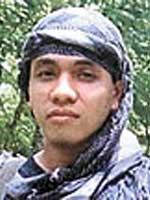Khadaffy Janjalani | |
|---|---|
 Khadafi Abubakar Janjalani | |
| Born | Khadaffy Abubakar Janjalani March 3, 1975 Isabela, Basilan, Philippines |
| Died | September 4, 2006 (aged 31) Patikul, Sulu, Philippines |
| Cause of death | Gunshot wound |
| Nationality | Moro |
| Other names | Daf, Pek |
| Known for | Nominal leader of the Filipino militant group Abu Sayyaf |
| Predecessor | Abdurajik Abubakar Janjalani |
| Successor | Radullan Sahiron |
Khadaffy Abubakar Janjalani (also transliterated as Khadafy Janjalani, Khadafi Janjalani and Khaddafi Janjalani; March 3, 1975 – September 4, 2006) was a Filipino Islamist militant who was the leader of the Moro militant group known as Abu Sayyaf and the leader of one of its factions. He was a staunch Wahhabi follower.
Janjalani was also known as Daf or Pek. He was a citizen of the Philippines, of Tau Sūg and Ilonggo parentage,[1] and spoke both Tausug and Tagalog, as well as some Arabic. According to the FBI, he was quiet, reserved, indecisive and overconfident.
Janjalani was indicted in the United States District Court for the District of Columbia, for his alleged involvement in terrorist acts, including hostage kidnapping and murder, against United States nationals and other foreign nationals in and around the Republic of the Philippines. Janjalani allegedly served as the Amir or spiritual leader of Abu Sayyaf Group, which allegedly took the foreign nationals hostage.
For that indictment, on February 24, 2006, Janjalani was among six fugitives in the second and most recent group of indicted fugitives to be added to the FBI Most Wanted Terrorists list along with two fellow members of Abu Sayyaf.[2]
The United States government offered a 5 million US Dollar (216,000,000 PHP) reward for Janjalani's capture.
On December 27, 2006, the Philippine military reported that what appeared to be Janjalani's remains had been recovered near Patikul, on Sulu Island in the southern Philippines, and that DNA tests had been ordered to confirm the discovery. As related by fellow fighters taken prisoner, he was shot in the neck in an encounter with government troops in September on Luba Hills, Patikul town, Sulu Island. On January 20, 2007, Military Chief General Hermogenes Esperon Jr. announced the identity of the corpse was confirmed, through a DNA comparison with a brother of the militant conducted by the American FBI.
- ^ Unson, John (April 16, 2017). "Mindanao Development Pushing Abu Sayyaf Out —Security Officials". The Philippine Star.
- ^ "FBI Updates Most Wanted Terrorists and Seeking Information – War on Terrorism Lists". Federal Bureau of Investigation. February 24, 2006. Archived from the original on January 29, 2010.